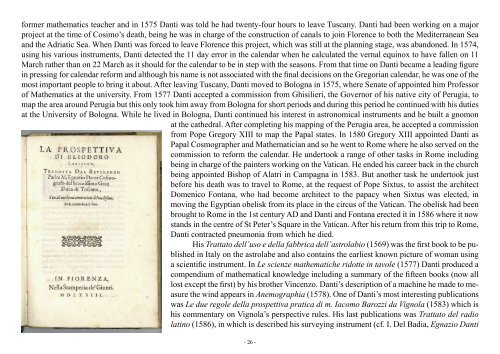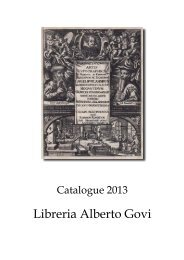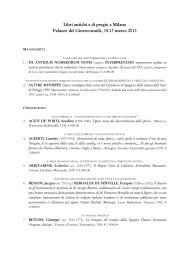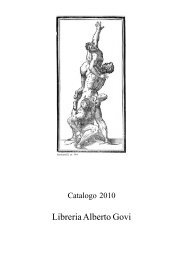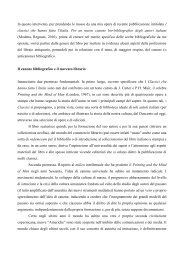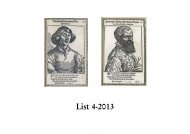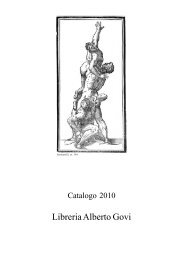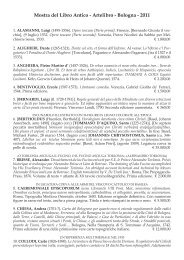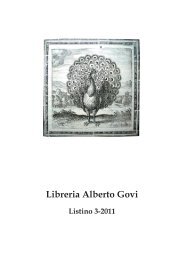List 1-2013.pdf - Libreria Antiquaria Alberto Govi
List 1-2013.pdf - Libreria Antiquaria Alberto Govi
List 1-2013.pdf - Libreria Antiquaria Alberto Govi
Create successful ePaper yourself
Turn your PDF publications into a flip-book with our unique Google optimized e-Paper software.
former mathematics teacher and in 1575 Danti was told he had twenty-four hours to leave Tuscany. Danti had been working on a major<br />
project at the time of Cosimo’s death, being he was in charge of the construction of canals to join Florence to both the Mediterranean Sea<br />
and the Adriatic Sea. When Danti was forced to leave Florence this project, which was still at the planning stage, was abandoned. In 1574,<br />
using his various instruments, Danti detected the 11 day error in the calendar when he calculated the vernal equinox to have fallen on 11<br />
March rather than on 22 March as it should for the calendar to be in step with the seasons. From that time on Danti became a leading figure<br />
in pressing for calendar reform and although his name is not associated with the final decisions on the Gregorian calendar, he was one of the<br />
most important people to bring it about. After leaving Tuscany, Danti moved to Bologna in 1575, where Senate of appointed him Professor<br />
of Mathematics at the university. From 1577 Danti accepted a commission from Ghisilieri, the Governor of his native city of Perugia, to<br />
map the area around Perugia but this only took him away from Bologna for short periods and during this period he continued with his duties<br />
at the University of Bologna. While he lived in Bologna, Danti continued his interest in astronomical instruments and he built a gnomon<br />
at the cathedral. After completing his mapping of the Perugia area, he accepted a commission<br />
from Pope Gregory XIII to map the Papal states. In 1580 Gregory XIII appointed Danti as<br />
Papal Cosmographer and Mathematician and so he went to Rome where he also served on the<br />
commission to reform the calendar. He undertook a range of other tasks in Rome including<br />
being in charge of the painters working on the Vatican. He ended his career back in the church<br />
being appointed Bishop of Alatri in Campagna in 1583. But another task he undertook just<br />
before his death was to travel to Rome, at the request of Pope Sixtus, to assist the architect<br />
Domenico Fontana, who had become architect to the papacy when Sixtus was elected, in<br />
moving the Egyptian obelisk from its place in the circus of the Vatican. The obelisk had been<br />
brought to Rome in the 1st century AD and Danti and Fontana erected it in 1586 where it now<br />
stands in the centre of St Peter’s Square in the Vatican. After his return from this trip to Rome,<br />
Danti contracted pneumonia from which he died.<br />
His Trattato dell’uso e della fabbrica dell’astrolabio (1569) was the first book to be published<br />
in Italy on the astrolabe and also contains the earliest known picture of woman using<br />
a scientific instrument. In Le scienze mathematiche ridotte in tavole (1577) Danti produced a<br />
compendium of mathematical knowledge including a summary of the fifteen books (now all<br />
lost except the first) by his brother Vincenzo. Danti’s description of a machine he made to measure<br />
the wind appears in Anemographia (1578). One of Danti’s most interesting publications<br />
was Le due regole della prospettiva pratica di m. Iacomo Barozzi da Vignola (1583) which is<br />
his commentary on Vignola’s perspective rules. His last publications was Trattato del radio<br />
latino (1586), in which is described his surveying instrument (cf. I. Del Badia, Egnazio Danti<br />
- 26 -


